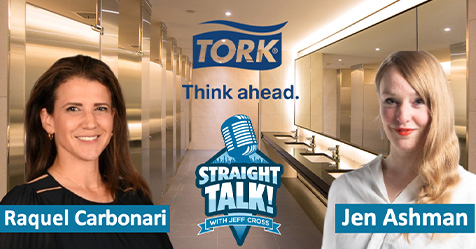Q: How did COVID-19 impact demand for touchless restroom dispensers?
A: COVID-19 brought with it not only a fast-spreading superbug that led to a worldwide pandemic, but also a recognition that as individuals and businesses there was significant room for improvement in regard to hand hygiene. While touchless dispensers were certainly gaining ground in the years prior to the pandemic, COVID was a singular global event that took them from a ‘nice to have’ to a ‘need to have.’ There is simply no other category of dispenser that exists today that offers the same hygiene benefits as a touchless dispenser. Because of COVID, that message has been delivered loud and clear.
With its tumultuous effect on the economy, COVID has also led to a financial reckoning for businesses. Labor shortages, supply chain challenges, and inflation are all leading businesses to think longer and harder about where to cut costs and where to improve operational efficiencies. When it comes to facility operations and management, touchless dispensers help enable cost, labor, and product savings. Again, due to COVID, they’re no longer a ‘nice to have,’ they’re a ‘need to have.’
Q: Explain briefly how these touchless restroom dispensers work.
A: Automated touchless restroom dispensers are motion activated to dispense a pre-set amount of product—paper towel, soap, sanitizer. So, with the wave of the hand, the product is dispensed. The user never touches the dispensing unit itself nor do they touch more product than they receive. In this way, touchless dispensers help advance hygiene because the number of touchpoints is reduced and, therefore, the risk of cross contamination is reduced.
Q: What are the main drivers of going touchless? What are facility managers trying to achieve today with touchless dispensers?
A: To expand on what I noted earlier, more than ever, facility managers need their equipment to check off a number of boxes, including everything from hygiene to efficiency to cost savings to sustainability and more. Touchless dispensers do just that. First and foremost, they help advance hygiene. By the very nature of being touchless, these dispensers help reduce the risk of cross contamination because the product is contained and protected inside the dispenser, and the user doesn’t need to touch the dispenser itself.
Touchless systems also help control how much product is dispensed—whether that’s paper towel, soap, or hand sanitizer. This kind of product control offers a number of important benefits, like helping to reduce product usage and waste and supporting cost savings and environmental sustainability. And those benefits lead to more benefits. When less product is used, custodians don’t need to refill product as frequently, which impacts their efficiency and productivity.
Q: What are some of the new or improved features available in today’s restroom dispensers (traditional and touchless)?
A: Restroom dispensers today have features and technologies that collectively help deliver all those great hygiene and operational benefits. They’re designed to be easy for custodians to open and access, and they have quick-check indicators like warning lights and windows so custodians can quickly see if product needs to be replaced. Some paper towel dispensers offer dual-roll technology so the smallest roll is consumed first to help eliminate waste and virtually eliminate paper jams. There are soap dispensers that boast closed systems with a hygienically sealed nozzle and reservoir as part of a 100% recyclable refill, no disassembling of the bottle required. Really, the only thing dispensers can’t do is refill themselves.
Q: GP PRO has recent research that shows heavy facility investment in dispenser monitoring and alerts. Can you share what might be driving this investment?
A: In 2020 and 2021, GP PRO saw surging demand for touchless dispensers market-wide, creating the highest levels ever in the history of touchless dispensing. Our data and market research showed touchless paper towel dispenser demand was 20% higher than pre-COVID, and, in some months, it was as much as 25% greater than pre-pandemic averages. We believe these purchases were mostly to replace paddle- or crank-driven units and folded towel dispensers in an effort to improve facility hygiene and better serve customers and employees.
Q: What are some trends you see happening in restroom dispenser design now and looking ahead to the next five years?
A: Touchless dispensing has been growing in the market for over 20 years, and the pandemic-accelerated growth will absolutely make touchless the new normal in away-from-home facilities. Automated touchless dispensers address and help solve so many of the pressing problems facility managers face, that I think, if anything, we’ll see more and more innovation here in terms of unit capacity, ease of use, and training as facilities continue to struggle with labor shortages and need to be very deliberate in how labor resources are deployed.
Q: Is there anything else you would like to mention about restroom dispensers?
A: GP PRO has conducted research about how users currently interact with public restrooms and how they want to interact with them. It should come as no surprise that the majority of consumers want clean, well-stocked and well-functioning restrooms so they can get in and get out. In fact, our research found that 48% of employees expect this of their workplace, and 89% say it contributes to their workplace satisfaction (CBT-21-5118). In addition to installing touchless dispensers, facility managers might also consider installing and deploying a smart restroom solution. A smart restroom solution that monitors and helps manage dispenser levels really elevates and amplifies the benefits of touchless dispensers—taking hygiene, operational efficiency, productivity, sustainability, cost savings, and user satisfaction to an entirely new level.



